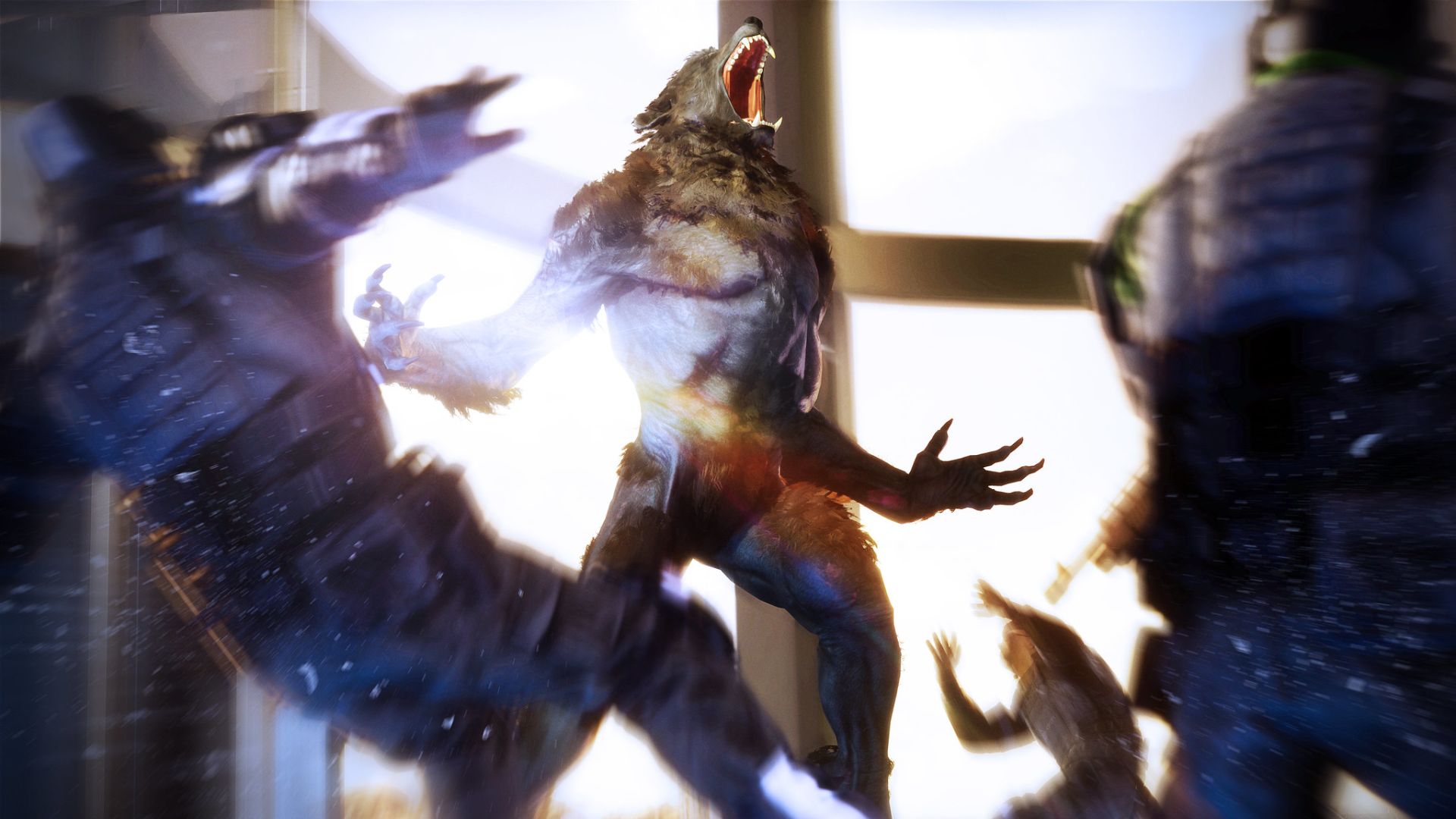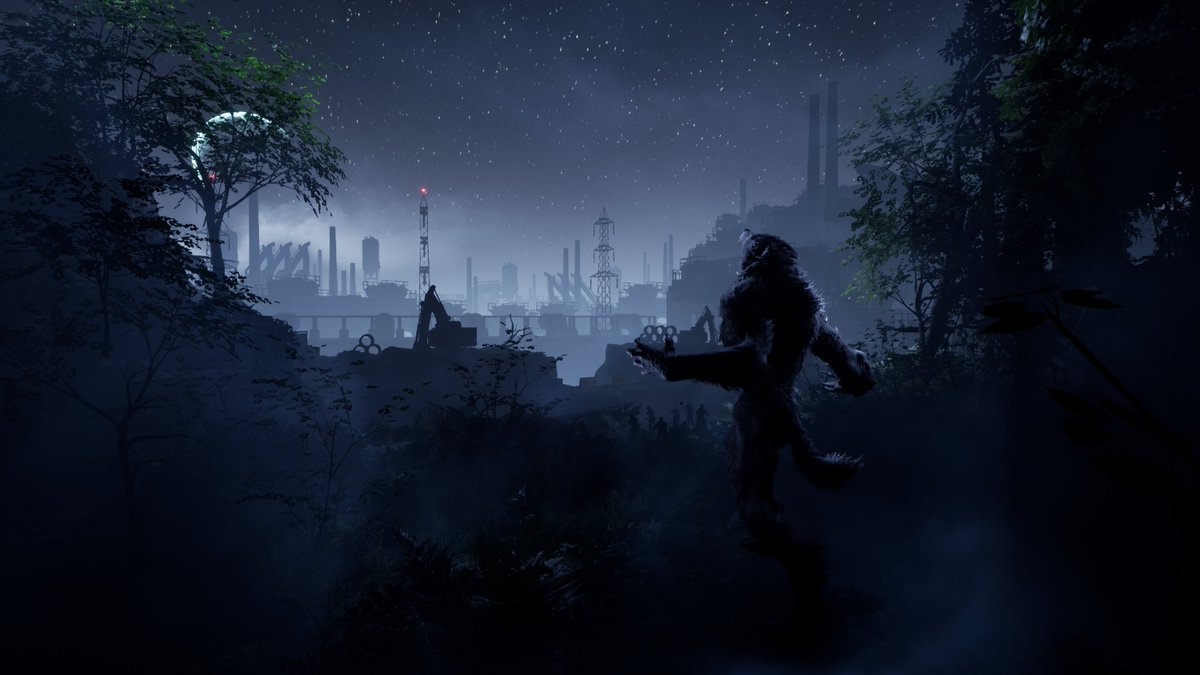
After some impressive showcases at E3, Werewolf: The Apocalypse – Earthblood seemed to have some real momentum behind it. The Werewolf: The Apocalypse series comes from the larger World of Darkness franchise, which includes other notable names like Vampire: The Masquerade, and Cyanide Studio’s Earthblood is one of the entire franchise’s first forays into action video games. Its E3 demos impressed because they highlighted a seemingly impressive gameplay loop in which you can switch between human and werewolf at will to fight your enemies. As a full package, though, Earthblood offers very little more than these showcases highlighted. What was intriguing for a short demo becomes stale and repetitive over the course of an 8-hour experience, and the surrounding presentation lets down the few good ideas lying in the gameplay. For everything that makes Werewolf: The Apocalypse an interesting idea, both in its tabletop RPGs and its pre-release content, there are too many other problems in Earthblood to make it an essential addition to the World of Darkness franchise.
At its core, Earthblood stays true to its source material. You take control of Cahal, who is part of a clan of Garou, beings who can switch between the default human, the quieter and quicker wolf, and the larger and stronger werewolf, which is only available when Cahal gives into his Incredible Hulk-style rage. The overarching villain is the energy megacorporation Endron, which has some cartoonishly evil schemes that Cahal and the entire clan want to stop by infiltrating their facilities and taking down their operations.
"For everything that makes Werewolf: The Apocalypse an interesting idea, both in its tabletop RPGs and its pre-release content, there are too many other problems in Earthblood to make it an essential addition to the World of Darkness franchise."
In gameplay, the possibility to switch back and forth between forms allows for different theoretical paths through every encounter. Each encounter is effectively split into individual rooms of enemies, and most can be completed with either stealth or action. Stealth is a relatively industry-standard affair, though adding the wolf element makes it mildly more interesting. You try to pick off enemies one-by-one until the room is clear, and certain guard patterns often make it evident as to which order is most efficient to avoid being spotted. Unfortunately, there are very few options to assist with your stealth, apart from hiding behind barriers and using the wolf to fit into some very conveniently placed ventilation ducts. You can only take down one enemy at a time; there aren’t any distraction techniques; and there are commonly pairs of guards looking in opposite directions to make staying hidden almost impossible. You have a crossbow with severely limited ammo, but even using this can unexpectedly alert nearby enemies anyway.
If you are ultimately spotted, which you will inevitably be in the vast majority of encounters, you automatically turn into your werewolf form, where you are much more powerful and are thrust into the center of combat. Taking control of the werewolf is easily the game’s most impressive and enjoyable feature, simply because of how powerful it makes you feel. You can take down the average security guard in a single blow, and you can traverse entire rooms in an instant. Naturally, the game won’t let you fight only those weak guards, so there are some big robots and guards with shields that make you do a little more work to bring them down, including some late-game enemies that feel almost unfairly spongey for their size. What gives you a leg up in combat is your Rage, a meter that builds up as you take down enemies and allows you to perform stronger special attacks and heal yourself. You also build up a Frenzy meter, which, when filled, lets you go into a much more powerful, almost invincible state that effectively serves as a get out of jail free card. Even in boss fights, filling the Frenzy meter was more often than not a death sentence for the boss, regardless of how much health they had left.
These moments of pure strength make up Earthblood’s most satisfying gameplay moments, but the gameplay is otherwise diluted, making these moments fleeting. While the werewolf combat is great in spurts and has its strengths, it becomes altogether too repetitive to stand up on its own. For a game with this werewolf combat, it would make sense that it wants you to get into action more than stealth and would make the stealth more difficult, but it’s puzzling why it feels like it punishes you for being spotted. When you get into combat, you’re almost inevitably going to face multiple waves of enemies through reinforcements, and, while you can technically disable some reinforcements by locking their doors, it never felt like there were ever any fewer, even if I had disabled every door.
"While the werewolf combat is great in spurts and has its strengths, it becomes altogether too repetitive to stand up on its own."
Moreover, there are only a handful of distinct enemy types outside of bosses, and this game falls into the trap of making the game more difficult simply by adding more enemies, which is both frustrating and overwhelming, especially when you’re multiple waves deep in an encounter. This all creates a combat environment that feels punishing without much reward or diversity. By the end, I wasn’t having much fun taking down enemies because it felt like the game was trying to work against me with too many waves of enemies or an unending sequence of encounters with no respite. Even boss battles, which are some of the more interesting combat encounters, felt more like brief interludes between the repetitive combat than special combat encounters that tested my skills.
There are a few other gameplay interludes that break up the combat sections. The game is semi-open world, as you can explore the environments on your own time or return to your base, where you can talk to other members of your clan. But I never felt a reason to do this. The environments are drab and lifeless outside of the main mission areas, and there’s little to find. The collectibles you can find around the world add little to either the gameplay or the story, and mission markers almost always lead you directly down the linear path you need to take to progress the story.
Even the few side missions are generally contained as minor offshoots of linear sequences, and they’re very insubstantial, as are the dialogue trees, which have no real purpose here. Some dialogue choices allow you to give into rage and fight the person you’re talking to, but again, this choice feels unimportant and has few repercussions. If you do move around the environments, you’ll likely be using Lupus, Cahal’s wolf form, which is a more enjoyable way to move around because he can run faster and jump higher, and when you’re not in combat, there’s overall little reason to ever switch away from Lupus. The game forces you back to Cahal’s human form when he talks or interacts with something, but this feels more restrictive than necessary, especially when he continues talking when you want to switch back to Lupus for stealth.
"The game forces you back to Cahal’s human form when he talks or interacts with something, but this feels more restrictive than necessary, especially when he continues talking when you want to switch back to Lupus for stealth."
The story feels half-baked as well. The game takes place five years after Cahal leaves his clan of Garou for failing to save his wife from death. Cahal returns to the clan to help them in their plot to tear down Endron, the reasons for which are unusually both unclear and overbearing. At first, it seems to be assumed that Endron is bad because they are an energy megacorporation, without much explanation as to why. You are tasked with entering the facilities and killing hundreds of workers, some of which are civilian employees, which they justify at one point by saying that anyone who works for Endron is complicit with their schemes and deserves to die.
Later on, there is an almost cartoonishly evil plot by Endron to utilize a new biofuel, the eponymous Earthblood, in their subjects, but the motivations for doing so are never really explained. It feels like Endron is just there as a binary evil who you’re expected to hate without much explanation or justification, but for a game that thematically explores controlling your rage and anger, it’s not particularly apt to unilaterally hate a company without any grey area. As the game progresses, too, there is a sharp turn in the story that comes almost out of nowhere and feels like an entirely new game. Cahal’s motivations here are admittedly more direct, but much of it still goes unexplained and the ending doesn’t do much to wrap up many of the game’s questions.
The game’s writing doesn’t help the story’s issues either. Dialogue is very hit-or-miss, and the voice performances are often emotionally misguided. Characters rarely react to things in a natural way, which isn’t helped by the character models and animations, which can feel janky and stiff, especially in dialogue. It’s not the most graphically compelling game, though there are some intriguing places in each environment, and even in combat enemies animate in distractingly unnatural ways. As a silver lining, while it doesn’t push the next-generation hardware to its limits, it had few bugs and ran smoothly for my entire playthrough, even with a large number of enemies on screen at once.
"Later on, there is an almost cartoonishly evil plot by Endron to utilize a new biofuel, the eponymous Earthblood, in their subjects, but the motivations for doing so are never really explained."
What makes werewolves an interesting gameplay concept is their ability to change in an instant to the most powerful being in the room. Werewolf: The Apocalypse – Earthblood tries to expand on that gameplay concept but never really ascends above its floor. The gameplay itself becomes stale over the course of just a few hours, and the presentation and story make the motivations and themes both more confusing and less intriguing. Apart from intermittent moments of sheer power, Earthblood never realizes its potential in almost any area, and what seems like a great idea on paper turns into an underrealized mess.
This game was reviewed on the Xbox Series X.
Powerful werewolf form; Wolf’s quick traversal.
Repetitive gameplay; Stale enemy types; Unexplained binary story; Dated graphics and environments; Subpar writing and performances.


















